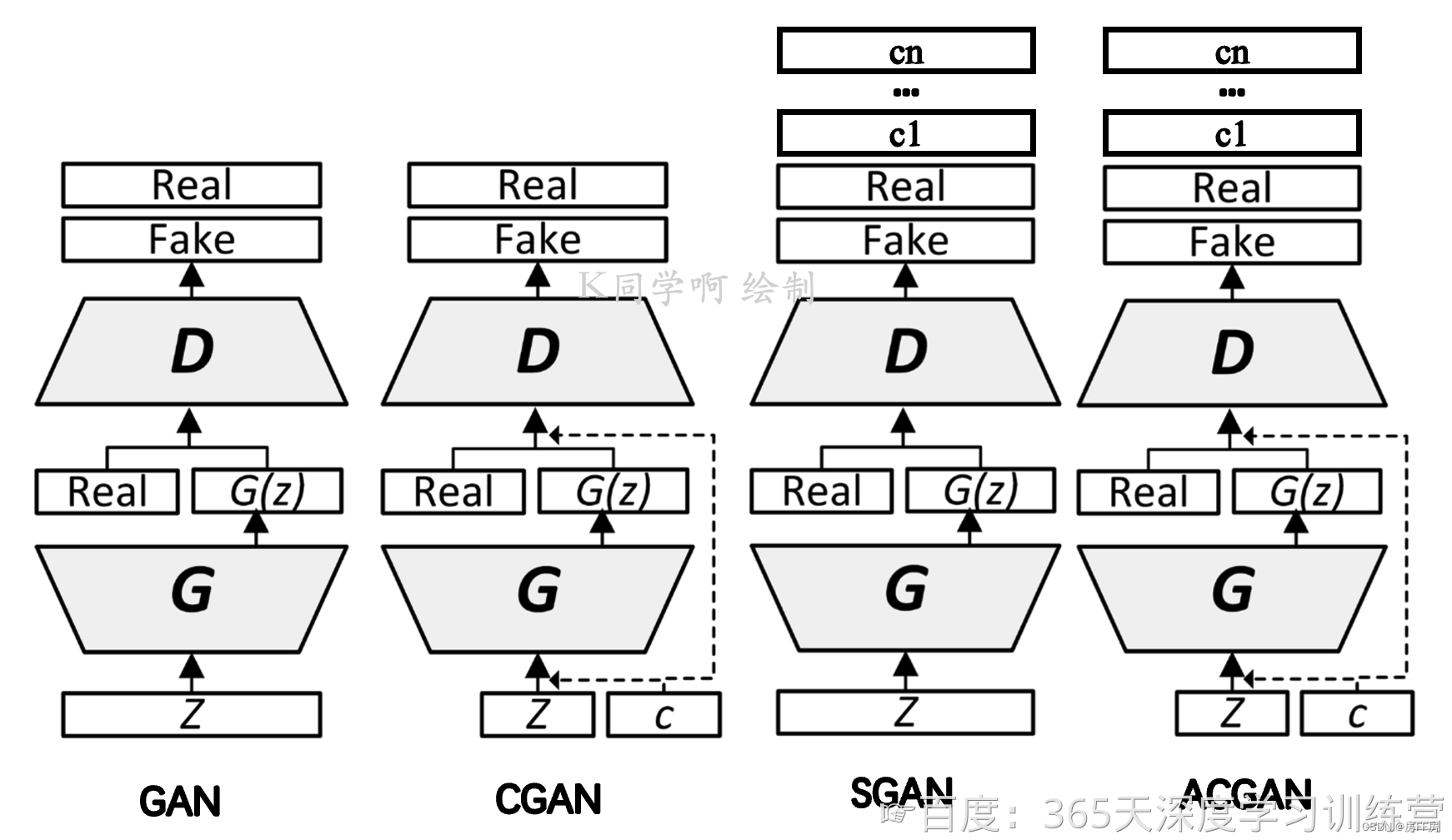- 🍨 本文为🔗365天深度学习训练营 中的学习记录博客
- 🍖 原作者:K同学啊

ACGAN的网络结构其实和之前的CGAN和SGAN都非常接近,可以说是两者的结合体。但这样的修改可以有效生成高质量的生成结果,并且使得训练更加稳定。
根据框架图,如何写出代码?
1.CGAN代码实现
定义生成器 Generator
'''
定义生成器 Generator
'''
class Generator(nn.Module):
def __init__(self):
super(Generator, self).__init__()
# 定义条件标签的生成器部分,用于将标签映射到嵌入空间中
# n_classes:条件标签的总数
# embedding_dim:嵌入空间的维度
self.label_conditioned_generator = nn.Sequential(
nn.Embedding(n_classes, embedding_dim), # 使用Embedding层将条件标签映射为稠密向量
nn.Linear(embedding_dim, 16) # 使用线性层将稠密向量转换为更高维度
)
# 定义潜在向量的生成器部分,用于将噪声向量映射到图像空间中
# latent_dim:潜在向量的维度
self.latent = nn.Sequential(
nn.Linear(latent_dim, 4*4*512), # 使用线性层将潜在向量转换为更高维度
nn.LeakyReLU(0.2, inplace=True) # 使用LeakyReLU激活函数进行非线性映射
)
# 定义生成器的主要结构,将条件标签和潜在向量合并成生成的图像
self.model = nn.Sequential(
# 反卷积层1:将合并后的向量映射为64x8x8的特征图
nn.ConvTranspose2d(513, 64*8, 4, 2, 1, bias=False),
nn.BatchNorm2d(64*8, momentum=0.1, eps=0.8), # 批标准化
nn.ReLU(True), # ReLU激活函数
# 反卷积层2:将64x8x8的特征图映射为64x4x4的特征图
nn.ConvTranspose2d(64*8, 64*4, 4, 2, 1, bias=False),
nn.BatchNorm2d(64*4, momentum=0.1, eps=0.8),
nn.ReLU(True),
# 反卷积层3:将64x4x4的特征图映射为64x2x2的特征图
nn.ConvTranspose2d(64*4, 64*2, 4, 2, 1, bias=False),
nn.BatchNorm2d(64*2, momentum=0.1, eps=0.8),
nn.ReLU(True),
# 反卷积层4:将64x2x2的特征图映射为64x1x1的特征图
nn.ConvTranspose2d(64*2, 64*1, 4, 2, 1, bias=False),
nn.BatchNorm2d(64*1, momentum=0.1, eps=0.8),
nn.ReLU(True),
# 反卷积层5:将64x1x1的特征图映射为3x64x64的RGB图像
nn.ConvTranspose2d(64*1, 3, 4, 2, 1, bias=False),
nn.Tanh() # 使用Tanh激活函数将生成的图像像素值映射到[-1, 1]范围内
)
def forward(self, inputs):
noise_vector, label = inputs
# 通过条件标签生成器将标签映射为嵌入向量
label_output = self.label_conditioned_generator(label)
# 将嵌入向量的形状变为(batch_size, 1, 4, 4),以便与潜在向量进行合并
label_output = label_output.view(-1, 1, 4, 4)
# 通过潜在向量生成器将噪声向量映射为潜在向量
latent_output = self.latent(noise_vector)
# 将潜在向量的形状变为(batch_size, 512, 4, 4),以便与条件标签进行合并
latent_output = latent_output.view(-1, 512, 4, 4)
# 将条件标签和潜在向量在通道维度上进行合并,得到合并后的特征图
concat = torch.cat((latent_output, label_output), dim=1)
# 通过生成器的主要结构将合并后的特征图生成为RGB图像
image = self.model(concat)
return image
# 创建生成器
generator = Generator().to(device)
# 使用 "weights_init" 函数对所有权重进行随机初始化,
# 平均值(mean)设置为0,标准差(stdev)设置为0.02。
generator.apply(weights_init)
# 打印生成器模型
print(generator)定义判别器 Discriminator
'''
定义判别器 Discriminator
'''
class Discriminator(nn.Module):
def __init__(self):
super(Discriminator, self).__init__()
# 定义一个条件标签的嵌入层,用于将类别标签转换为特征向量
self.label_condition_disc = nn.Sequential(
nn.Embedding(n_classes, embedding_dim), # 嵌入层将类别标签编码为固定长度的向量
nn.Linear(embedding_dim, 3*128*128) # 线性层将嵌入的向量转换为与图像尺寸相匹配的特征张量
)
# 定义主要的鉴别器模型
self.model = nn.Sequential(
nn.Conv2d(6, 64, 4, 2, 1, bias=False), # 输入通道为6(包含图像和标签的通道数),输出通道为64,4x4的卷积核,步长为2,padding为1
nn.LeakyReLU(0.2, inplace=True), # LeakyReLU激活函数,带有负斜率,增加模型对输入中的负值的感知能力
nn.Conv2d(64, 64*2, 4, 3, 2, bias=False), # 输入通道为64,输出通道为64*2,4x4的卷积核,步长为3,padding为2
nn.BatchNorm2d(64*2, momentum=0.1, eps=0.8), # 批量归一化层,有利于训练稳定性和收敛速度
nn.LeakyReLU(0.2, inplace=True),
nn.Conv2d(64*2, 64*4, 4, 3, 2, bias=False), # 输入通道为64*2,输出通道为64*4,4x4的卷积核,步长为3,padding为2
nn.BatchNorm2d(64*4, momentum=0.1, eps=0.8),
nn.LeakyReLU(0.2, inplace=True),
nn.Conv2d(64*4, 64*8, 4, 3, 2, bias=False), # 输入通道为64*4,输出通道为64*8,4x4的卷积核,步长为3,padding为2
nn.BatchNorm2d(64*8, momentum=0.1, eps=0.8),
nn.LeakyReLU(0.2, inplace=True),
nn.Flatten(), # 将特征图展平为一维向量,用于后续全连接层处理
nn.Dropout(0.4), # 随机失活层,用于减少过拟合风险
nn.Linear(4608, 1), # 全连接层,将特征向量映射到输出维度为1的向量
nn.Sigmoid() # Sigmoid激活函数,用于输出范围限制在0到1之间的概率值
)
def forward(self, inputs):
img, label = inputs
# 将类别标签转换为特征向量
label_output = self.label_condition_disc(label)
# 重塑特征向量为与图像尺寸相匹配的特征张量
label_output = label_output.view(-1, 3, 128, 128)
# 将图像特征和标签特征拼接在一起作为鉴别器的输入
concat = torch.cat((img, label_output), dim=1)
# 将拼接后的输入通过鉴别器模型进行前向传播,得到输出结果
output = self.model(concat)
return output
# 创建判别器对象
discriminator = Discriminator().to(device)
# 应用 "weights_init" 函数来随机初始化所有权重
# 使用 mean=0, stdev=0.2 的方式进行初始化
discriminator.apply(weights_init)
# 打印判别器模型
print(discriminator)2.SGAN代码实现
定义判别器 Discriminator
class Discriminator(nn.Module):
def __init__(self):
super(Discriminator, self).__init__()
def discriminator_block(in_filters, out_filters, bn=True):
"""返回每个鉴别器块的层"""
block = [nn.Conv2d(in_filters, out_filters, 3, 2, 1), nn.LeakyReLU(0.2, inplace=True), nn.Dropout2d(0.25)]
if bn:
block.append(nn.BatchNorm2d(out_filters, 0.8))
return block
# 鉴别器的卷积块
self.conv_blocks = nn.Sequential(
*discriminator_block(opt.channels, 16, bn=False),
*discriminator_block(16, 32),
*discriminator_block(32, 64),
*discriminator_block(64, 128),
)
# 下采样图像的高度和宽度
ds_size = opt.img_size // 2 ** 4
# 输出层
self.adv_layer = nn.Sequential(nn.Linear(128 * ds_size ** 2, 1), nn.Sigmoid()) # 用于鉴别真假的输出层
self.aux_layer = nn.Sequential(nn.Linear(128 * ds_size ** 2, opt.num_classes + 1), nn.Softmax()) # 用于鉴别类别的输出层
def forward(self, img):
out = self.conv_blocks(img)
out = out.view(out.shape[0], -1)
validity = self.adv_layer(out)
label = self.aux_layer(out)
return validity, labelDiscriminator区别:返回不同
Conditional GAN:CGAN
G:将类标签作为条件信息和噪声一起放入G后生成样本
D:将类标签和生成样本或者训练样本放入D,D的输出是输出样本为真假的概率或者0,1二值
Semi-supervised GAN:
G:不输入类别,只输入噪声来生成样本
D:输入生成样本或者训练样本,最后的输入是输入图像所属类别或者输入图像为假,一共N+1维(N是总类别数)
ACGAN同时结合了CGAN和SGAN的做法来提高图片的生成质量,即CGAN通过结合标签信息来提高生成数据的质量,SGAN通过重建标签信息来提高生成数据的质量。
在ACGAN中,主要是在原CGAN的基础上,对判别器的输入进行改变,不仅要输出图片的真假信息,同时还对应一个分类器来判断输入图片所属的类别,对应类别的损失会告诉判别器和生成器往着目标类别生成图片。
3.ACGAN代码
# 生成器网络类
class Generator(nn.Module):
def __init__(self):
super(Generator, self).__init__()
# 为类别标签创建嵌入层
self.label_emb = nn.Embedding(opt.n_classes, opt.latent_dim)
# 计算上采样前的初始大小
self.init_size = opt.img_size // 4 # Initial size before upsampling
# 第一层线性层
self.l1 = nn.Sequential(nn.Linear(opt.latent_dim, 128 * self.init_size ** 2))
# 卷积层块
self.conv_blocks = nn.Sequential(
nn.BatchNorm2d(128),
nn.Upsample(scale_factor=2),
nn.Conv2d(128, 128, 3, stride=1, padding=1),
nn.BatchNorm2d(128, 0.8),
nn.LeakyReLU(0.2, inplace=True),
nn.Upsample(scale_factor=2),
nn.Conv2d(128, 64, 3, stride=1, padding=1),
nn.BatchNorm2d(64, 0.8),
nn.LeakyReLU(0.2, inplace=True),
nn.Conv2d(64, opt.channels, 3, stride=1, padding=1),
nn.Tanh(),
)
def forward(self, noise, labels):
# 将标签嵌入到噪声中
gen_input = torch.mul(self.label_emb(labels), noise)
# 通过第一层线性层
out = self.l1(gen_input)
# 重新整形为合适的形状
out = out.view(out.shape[0], 128, self.init_size, self.init_size)
# 通过卷积层块生成图像
img = self.conv_blocks(out)
return img
# 判别器网络类
class Discriminator(nn.Module):
def __init__(self):
super(Discriminator, self).__init__()
# 定义判别器块的函数
def discriminator_block(in_filters, out_filters, bn=True):
"""返回每个判别器块的层"""
block = [nn.Conv2d(in_filters, out_filters, 3, 2, 1), nn.LeakyReLU(0.2, inplace=True), nn.Dropout2d(0.25)]
if bn:
block.append(nn.BatchNorm2d(out_filters, 0.8))
return block
# 判别器的卷积层块
self.conv_blocks = nn.Sequential(
*discriminator_block(opt.channels, 16, bn=False),
*discriminator_block(16, 32),
*discriminator_block(32, 64),
*discriminator_block(64, 128),
)
# 下采样后图像的高度和宽度
ds_size = opt.img_size // 2 ** 4
# 输出层
self.adv_layer = nn.Sequential(nn.Linear(128 * ds_size ** 2, 1), nn.Sigmoid())
self.aux_layer = nn.Sequential(nn.Linear(128 * ds_size ** 2, opt.n_classes), nn.Softmax())
def forward(self, img):
out = self.conv_blocks(img)
out = out.view(out.shape[0], -1)
validity = self.adv_layer(out)
label = self.aux_layer(out)
return validity, label





















 2000
2000











 被折叠的 条评论
为什么被折叠?
被折叠的 条评论
为什么被折叠?










